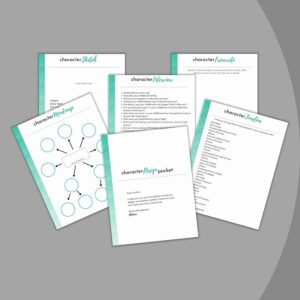
Character Design
Character design is an integral part of the writing process. Designing the characters that will populate our story worlds is complicated. It takes time, effort, and lots of brain power to create characters readers will love, or at least be able to relate to.
One of the most important aspects of character design is to add emotions. No one wants to read about a character devoid of emotion because that is 1) not realistic, and 2) super boring.
The characters are what appeal to readers. They are what pull the readers into our world and keep them captivated. Readers have to care about the story to keep reading it, and the reason they care about the story is because they care about the characters. In other words, caring about the characters leads to caring about the story.
Have you ever started a book and felt like you didn’t care what happened? It’s probably because you didn’t feel a connection to the characters, and, therefore, didn’t care about reading the story. And you did what authors dread most: you stopped reading and put the book down.
Creating realistic, multi-dimensional characters is crucial if we want people to read our books–and better, if we want readers to turn into fans, who are anxiously waiting for our next book.
How do we design characters that are so fully developed they feel like they could be our next door neighbors?
Use Real Life in Your Character Design
Some years ago, I took my daughter to the DMV to take her driving test. Upon our arrival, the lady at the counter snapped, “Do you realize you are 20 minutes late?”
We both answered, “Yes.” (My son was recently married and this last weekend we had the open house as well as a house full of guests. I was a little exhausted and we lived 30 minutes from town).
She then proceeded to tell us that my daughter would have to wait because she was late and the other appointment had shown up early and they were going to take him first to do his test. This was fine since we were late, but her ‘tude was rather annoying and, truthfully, every time I go to the DMV, I not only wait forever, but deal with crabby women. I’ve come to the conclusion that in order to work at the DMV you must be crabby (as well as make snide remarks) as that is part of the job description.
As I sat there waiting and waiting and waiting, I realized what a golden opportunity I had to not only glean personality characteristics from this woman to use in my writing, but to also analyze how it made me feel. Sometimes, I’m so caught up in what’s going on, I fail to realize how a situation can help me in my writing endeavors. The more observant we are, the better our stories will be. And the more we can pinpoint and understand our own feelings and apply them to our characters, the more realistic those characters will be to our readers.
Experience Emotions
Eliciting emotion from our readers comes from experiencing emotions ourselves and then capturing them on the page–perhaps that is why writers tend to be so passionate.
No experience in life is wasted if we can then use it in our writing. Did someone hurt your feelings? Make you mad? Insult you? Accuse you? Compliment you? Ask you for help? Tell you a secret? In each of those situations, how did it make you feel?
Maybe you’ve seen this meme on Facebook or elsewhere: “I’m a Writer. Don’t Annoy Me or I’ll Write You Into My Next Book.” That translates into: you’ve had an experience with someone who drew out your emotions. Harness those emotions and apply them to your characters.
When I first met my husband (many, many years ago), I also met a girl he was dating. Or, rather, a girl he’d dated and who wanted to keep dating him. When the three of us were involved in a couple of conversations, this girl did everything in her power to exclude me. Not only was she rude to me, she was extremely condescending. She tried to make me feel stupid any time I contributed to the conversation.
I used those feelings when, years later, I wrote a novel about a woman who has a similar experience. It helped me to remember those feelings so I could design a realistic character with genuine feelings.
Allowing myself to experience emotions helps me to write better stories.
Apply Feelings to Characters
When we can apply our feelings to our characters, we can make them more complex and realistic. Flat characters don’t experience emotion and they don’t jump off the page. Characters who experience true emotions throughout the pages of a book grab readers and make readers think about them long after they turn the last page.
When I first started writing (back before the internet even existed), I thought it was better to leave a lot to the imagination to the reader. I wrote very lean scenes because I was afraid of “telling” the reader too much.
I soon learned that wasn’t an effective way to write. Those who critiqued my stories would ask me, “How does she feel?” Since I didn’t want to “tell” readers how a character felt, I had to learn how to “show” their feelings. Once I learned how to do that, I wrote more fully-developed characters.
Characters are not chess pieces that we move around to meet our plot expectations, they are an integral part of the story as a whole and need to be fleshed out and feel like they are actual people.
Characters Feel Real
When I am deeply immersed in writing a novel, I can tell when I’ve done enough work to create the characters because I start wondering if the people in my book are real. One time, I was telling my husband about a situation and wondered what to do about it when I realized I was actually talking about people in my book, not real life. *facepalm*
As authors, we need to feel like our characters are real people and one of the best ways to do that is to infuse them with authentic emotions.
So, the next time you’re sitting at the DMV observing cranky employees, or defending your religious and/or political beliefs to a neighbor, or dealing with a rude customer service representative on the phone, pay attention to not only the details of what’s happening, but especially how it makes you feel and then apply those feelings to your characters to make them come alive on the page.
Who are your favorite characters? Why?
If you have any questions, please ask. You can also comment below.
Free Character Design Packet
I’ve created a Character Design Packet filled with awesome pages like Character Interview, Character Mindmap, and Character Freewrite. I’ve used these resources myself to create my own characters and I wanted to make it available to my readers for FREE. Isn’t that the best news? Who doesn’t love free?
And this packet has some great stuff, I’m telling you. Even better, it’s editable on your computer. That’s right. You can download this packet and fill it out on your computer! Or you can be old school, like me, and print it, then use your favorite pen to write it all out in long hand (I love the tactile feeling of actually hand writing–maybe I’m weird). Either way, this is a valuable resource. It will make you start thinking about your characters outside the box. My hope is that this packet will help you create compelling, realistic characters that will make your story come alive for readers.
You can download it here. You will need to join my StoryHelp Writing Tips Newsletter, but that’s awesome because you’ll get writing tips and special offers delivered right to your inbox every week. It’s a win-win :).

***Have you received my FREE course: Become an Idea Factory? You can click here to learn more about it. It’s a 7-day course delivered right to your inbox that helps you learn how to generate ideas. I know these techniques work because I use them! Find out more here.
***Do you already have a manuscript? If you can’t afford an editor, you might be interested in Pro Writing Aid Writing Software. This writing software helps you improve your writing to be the best it can be. It’s like having your own private editor for a fraction of the price. You can try it for free for 2 weeks. You can click here to learn more about it.






4 Comments
Pingback:
Pingback:
Pingback:
Pingback: